It’s easy to remember an encounter with these ants, especially if they sting
you. They’re big, bold, aggressive and fast.

The impressive mandibles of these ants form the least concerning part
part of their weaponry. This one is a Jumper Ant.
Bulldog Ants (also known as Bull Ants) and Jumper Ants are a group of large,
primitive ants from the genus Myrmecia. I must admit I don’t much
like them, but I do admire and certainly respect them.

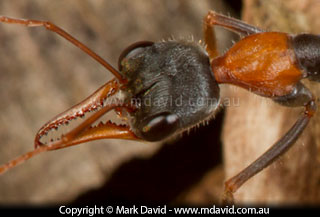
Jumper Ants
They jump
I don’t know about all Bull Ants, but the Jumper Ants can definitely jump.
I’ve watched them jump from leaf to leaf in trees. The ant stands on the edge
of one leaf and sways from side as it appears to judge the distance and angle and then
it leaps about 2 inches to the next leaf. They will also jump a lot when they’re
agitated.
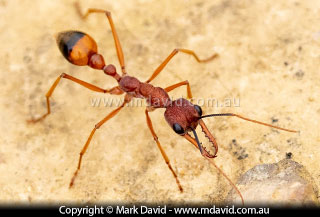
Bulldog Ant
Are they aggressive?
Absolutely. These ants are famous for their aggression. With their excellent eyesight
they will follow movement, even if the subject is much bigger than themselves. A few times
I’ve had Bull Ants try to chase me for a short distance. People reluctant to get too
close will be pleased to know it’s not difficult to outrun them.
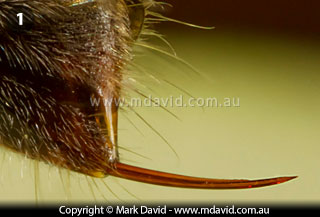
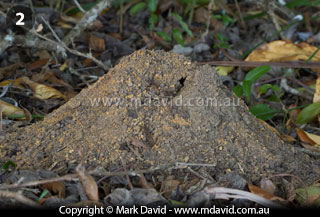
1: The bit you want to avoid: the stinger on this Jumper Ant injects venom.
2: The entrance to a Jumper Ant nest. While the nest is underground,
its location is usually revealed by an entrance mound like this one. The ants will actively
defend their nests and can leap out in great numbers when you disturb them.
Do they sting?
Absolutely. I’ve been stung by them and I am telling you right now that
it hurts. A lot. I will add that some people who are allergic to stings can suffer anaphylactic shock
from the stings so it can be very serious or even life-threatening in those instances,
especially since it is common to be stung repeatedly by lots of ants. Now I will point out that
it’s not the formidable mandibles which I am talking about, but a stinger in the abdomen
which they use to inject venom. The ants are aggressive enough on their own but when you get
too close to their nest they are even more likely to go for you, pouring out of their nest
like a miniature erupting volcano.
What do they eat?
You’d expect a creature with the attitude and athleticism of these ants to chase
cars and swallow the occupants whole but in fact their diet is much less exciting. They eat sweet stuff
like honeydew, seeds, fruit and nectar. They do, however, catch grubs and insect prey to take
back to their nest for the young to feed on.
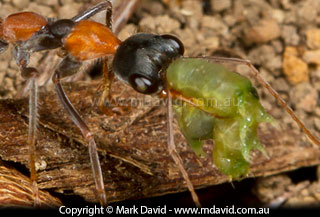
A worker Jumper Ant carries a tiny caterpillar back to the nest to feed to the young
How big do they get?
Big (for an ant). Jumper Ants grow to as long as 15mm, which I reckon is big enough
for any kind of ant, but the Bull Ants grow to the really impressive sizes of up to 40 mm
in length, making them one of the world’s longest ants.
Primitive
You probably already know that many arthropods were bigger back in the fossil eras. Bull
Ants and Jumper Ants have retained some of that size. But that’s not the only thing
primitive about them. They are directly descended from ancient ants that existed before
the arrival of other, more modern ants that developed the ability to walk in trails. Which
is why you never see a trail of Bull Ants. They always hunt on their own.
Where do they live?
Throughout Australia. If you’re an Aussie then chances are you’ve seen them.
The Jumper Ants exist only in Eastern Australia.


Birds

Insects and spiders

Other stuff














